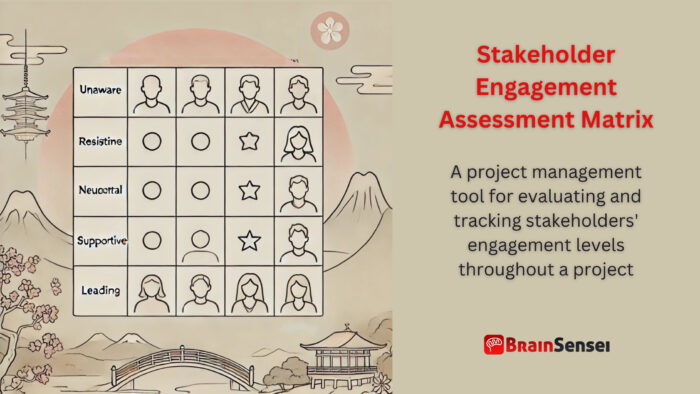
Stakeholder Engagement Assessment Matrix
What is a Stakeholder Engagement Assessment Matrix?
A stakeholder engagement assessment matrix is a project management tool for evaluating and tracking stakeholders’ engagement levels throughout a project. It helps project managers identify gaps between current and desired engagement levels, facilitating better communication, collaboration, and decision-making.
Key Takeaways
- Provides a clear overview of stakeholder engagement levels
- Helps bridge gaps between current and desired engagement
- Supports effective communication strategies
- Enhances project success by aligning stakeholder expectations
Understanding the Stakeholder Engagement Assessment Matrix
How It Works
The matrix categorizes stakeholders based on their level of engagement using predefined criteria. Common classifications include:
- Unaware: Uninformed about the project and its potential impact.
- Resistant: Aware but resistant to project objectives.
- Neutral: Aware but neither supportive nor resistant.
- Supportive: Advocates for project success.
- Leading: Actively engaged in ensuring project success.
As the project’s key driver, the project manager is crucial in regularly updating the matrix to monitor engagement shifts and adapt communication strategies accordingly. This responsibility gives them a sense of control and ownership, reinforcing their role in the project’s success.
Notes
- Accurate data collection is not just a task, but a responsibility that project managers must take seriously. It is essential for reliable insights and can significantly influence the project’s success, making the project manager feel the weight of their decisions and the impact on the project’s success.
- Stakeholder engagement can shift as the project evolves.
- Tailor communication strategies for different stakeholder groups.
- Misalignment can cause project delays and dissatisfaction.
Related Terms
- Stakeholder Analysis: Process of identifying and evaluating stakeholders.
- Stakeholder Register: A document that records stakeholder information.
- Communication Plan: Strategy outlining stakeholder communication.
- Project Charter: A document that formally authorizes a project.
- RACI Matrix: A tool to clarify roles and responsibilities.
Examples of Stakeholder Engagement Assessment Matrix in Different Industries
Construction Industry
A construction company uses the matrix to track engagement across various stakeholder groups, including government bodies, contractors, and local communities. For instance, the team identified residents as initially resistant during a large infrastructure project. Through targeted community meetings and transparent communication, residents shifted to a supportive stance, minimizing project delays.
The company conducted surveys and focus group discussions to understand residents’ concerns, primarily noise, traffic, and environmental impact. By addressing these concerns proactively, the company built trust and goodwill. Additionally, regular updates through newsletters and community events kept residents informed and engaged, reducing opposition and fostering a sense of shared ownership in the project.
Furthermore, the matrix helped the company identify that certain subcontractors were unaware of safety protocols, presenting potential risks to project timelines and workforce safety. In response, the project management team organized mandatory training sessions, ensuring alignment with safety standards and ultimately contributing to the project’s successful and timely completion.
Healthcare Industry
Administrators used the matrix in a hospital expansion project to engage medical staff, patients, and suppliers. Initially, medical staff were neutral due to concerns about workflow disruptions. However, by being involved in planning discussions and proactively addressing concerns, the staff moved to a supportive and eventually leading role.
The hospital formed a stakeholder committee comprising representatives from different departments to facilitate open communication and collaboration. Regular meetings allowed staff to voice concerns and offer suggestions, which were carefully documented and analyzed. Key changes, such as adjusting construction schedules to minimize patient care disruptions and incorporating staff feedback into facility design, significantly improved engagement levels.
Patients were also a critical stakeholder group. Surveys revealed they were unaware of the project’s goals and potential benefits. The hospital launched an information campaign using flyers, social media, and in-person events to educate patients about the improvements. As a result, patient support increased, with many expressing excitement about the enhanced facilities.
Telecommunications Sector
A telecom provider implementing a new 5G network employed the matrix to manage expectations among regulators, customers, and internal teams. The tool revealed regulatory authorities were unaware of the project’s scope. Focused outreach efforts improved engagement, enabling smoother regulatory approvals.
The company initiated workshops and briefing sessions to educate regulators about the project’s technical specifications, safety measures, and expected benefits. By proactively addressing regulatory concerns, the provider avoided potential compliance issues and secured the necessary permits without delays.
Internal teams also required attention. The matrix showed a gap in engagement within the technical support department, which was crucial for post-launch customer assistance. The company conducted specialized training programs to bridge this gap and created an internal knowledge base to equip support staff with the necessary skills and information.
Additionally, customer engagement was vital for the project’s success. Early feedback indicated skepticism about 5G technology’s benefits and safety. The company launched an educational marketing campaign to address these concerns, including webinars, blog posts, and interactive Q&A sessions. As a result, customer sentiment shifted positively, with increased interest and demand for the new service.
The matrix also highlighted regional variations in engagement levels. In urban areas, customers were generally supportive due to greater familiarity with technology. In contrast, rural communities exhibited more resistance. Tailored communication strategies, such as partnering with local influencers and hosting community events, effectively addressed concerns and boosted engagement.
Use Cases of Stakeholder Engagement Assessment Matrix
United States (Renewable Energy)
A renewable energy firm in California applied the matrix to a solar power plant project. Workshops and collaboration mitigated initial resistance from environmental groups, resulting in more substantial community support. The firm organized multiple public forums, provided educational materials, and worked with environmental leaders to address concerns about local wildlife impact. These steps helped shift community sentiment, fostering broader acceptance and involvement.
As the project progressed, the matrix revealed growing interest from local businesses seeking partnership opportunities. The firm established a stakeholder advisory board that included community representatives and environmental advocates. Regular feedback sessions helped address emerging concerns and build trust among all parties involved.
Germany (Software Development)
A software company developing a new application for public services found that end-users were unaware of the project. The team launched informational campaigns using the matrix, increasing engagement and adoption rates. Workshops and interactive demos provided practical insights into the application’s features, while user feedback channels addressed concerns promptly.
The company also collaborated with government bodies to align the software with regulatory requirements. The matrix highlighted the need for more training sessions for public employees, leading to the developing of a comprehensive onboarding program that significantly improved user satisfaction.
India (Automotive Industry)
An automotive manufacturer expanding operations utilized the matrix to involve local suppliers and government bodies. Early identification of concerns led to proactive problem-solving, ensuring timely project completion. The company organized supplier forums, distributed newsletters with project updates, and maintained open communication channels with regional authorities.
In addition, the matrix helped identify potential logistical bottlenecks early in the process. This foresight enabled the team to collaborate with transportation agencies to optimize delivery schedules, minimizing delays and reducing costs.
These cases demonstrate how the Stakeholder Engagement Assessment Matrix supports proactive communication, enhances stakeholder relationships, and contributes to successful project outcomes across diverse industries.
Best Practices for Stakeholder Engagement Assessment Matrix
Neglecting stakeholder engagement can lead to misinformation, delays, and dissatisfaction. Project managers should adopt a structured approach to stakeholder engagement to avoid these pitfalls. This approach involves regularly updating the matrix to reflect the current state of engagement and actively seeking stakeholder input to guide project decisions.
Effective best practices include tailoring communication strategies to suit different stakeholder groups. For example, senior executives prefer high-level reports and presentations, whereas operational teams benefit more from detailed documentation and regular meetings. Utilizing various communication channels, such as emails, meetings, and collaborative platforms, can help maintain engagement.
Additionally, building trust with stakeholders is crucial. Transparency about project objectives, progress, and challenges fosters confidence and encourages constructive contributions. The project team must establish conflict resolution mechanisms to address disagreements promptly and maintain a positive project environment.
Training and education play a significant role in stakeholder engagement. Project teams should conduct workshops and informational sessions to familiarize stakeholders with the project’s goals and their potential impact. Involving stakeholders to voice their concerns and offer feedback creates a sense of ownership and collaboration.
Another critical practice is documenting engagement activities and outcomes. This documentation helps track changes in stakeholder engagement over time and provides valuable insights for future projects. Lessons learned from past projects can be integrated into future engagement strategies to improve effectiveness.
Finally, leveraging technology can streamline stakeholder engagement. Tools like CRM systems, project management software, and digital communication platforms facilitate efficient information sharing and collaboration across geographically dispersed teams.
Common Mistakes and Issues
Mistakes in stakeholder engagement can lead to communication breakdowns, missed objectives, and project delays. One common mistake is failing to identify key stakeholders at the project’s inception. If the project team overlooks key stakeholders, their perspectives and concerns go unaddressed, potentially leading to opposition or disengagement later.
Another frequent issue is neglecting to update the matrix as the project progresses. Stakeholder engagement is dynamic, and failure to reflect these changes can result in outdated communication strategies that no longer resonate with the audience. Regular reviews and updates ensure the matrix remains relevant and accurate.
Another pitfall is inadequate communication. Some project teams assume that generic, one-size-fits-all communication plans suffice for all stakeholders. However, different groups have unique information needs and preferences. For example, technical teams may require detailed specifications, whereas executives prefer high-level summaries.
Additionally, ignoring stakeholder feedback can erode trust and engagement. When stakeholders feel disregarded, they may become resistant or disengaged. Establishing mechanisms for continuous input and visibly incorporating suggestions where possible helps maintain strong relationships.
A real-world example of these mistakes occurred during a multinational IT project’s rollout. The team underestimated the impact on regional offices and failed to engage local managers early. As a result, resistance grew, requiring costly interventions to realign efforts. This case underscores the importance of proactive, inclusive, and adaptive engagement practices.
Frequently Asked Questions (FAQs)
What is the purpose of a Stakeholder Engagement Assessment Matrix?
The matrix helps project managers track and improve stakeholder engagement to align efforts with project goals.
How often should the Stakeholder Engagement Assessment Matrix be updated?
Regular updates are recommended, particularly after significant project milestones or stakeholder interactions.
Who is responsible for maintaining the Stakeholder Engagement Assessment Matrix?
Project managers typically oversee the matrix, but input from team members and stakeholders is essential.
Can the matrix be used in small projects?
Yes, even small projects benefit from understanding and managing stakeholder engagement.
What tools can support matrix development?
Project management software like Microsoft Project, Asana, and Monday.com can streamline matrix creation and maintenance.
Additional Resources
Preparing for a PMI certification?
- Exam Prep Courses: PMP®, CAPM®, and PMI-ACP®
- Exam Simulators: PMP®, CAPM®, PMI-ACP®, PMI-PBA®, PMI-RMP®, PMI-SP®, PgMP®, and PfMP®
- Professional Development Units (PDUs): 15, 30, and 60 PDU Bundles



